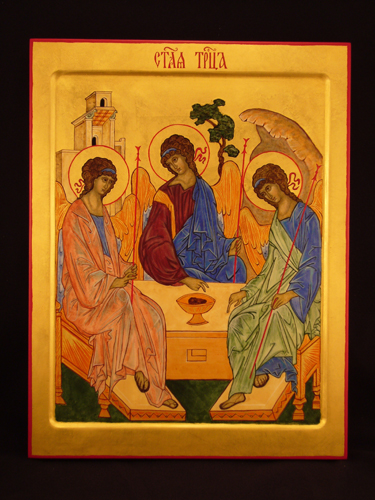| |Home |
|Subscribe |
|Donate |
|Join |
|About |
|Contact |
||

exhibiting artists
Ken Arnold
Roger Beattie
Kathrin Burleson
Mary Anne Carley
Dennis Di Vicenzo
Lorna Effler
Paul Fromberg
Susan Goff
Janice Holman
Moses Hoskins
Ann Kim
Judy Gibson King
Audrey Lee
Mary Mayer
Nicole Maynard
Judith McManis
Zachary Roesemann
Claudia Smith
Patricia Smith
Kathy Thaden
Susan Tilt
Barbi Tinder
Vanessa Wells
Jeff Wunrow
 |
The Holy Trinity |
The iconography of the Holy Trinity is based on the story of three men, or angels, appearing to Abraham by the Oak of Mamre (Genesis 18). The early Fathers took this as an image of the Holy Trinity. Icons of this scene, called “The Hospitality of Abraham,” originally included Abraham and Sarah and members of their household preparing a feast for their visitors. In the early 1400s, Andrei Rublev, the great Russian iconographer, took the traditional scheme and pared it down to the three figures sitting around a table, focusing not on an historical Biblical event but rather on the mystery of the Trinity. The three figures, through their posture and gestures, suggest a subtle, exquisite circular movement that nonetheless does not break the sense of silence and peace—a solemn dance of three equals, the Three in One. In this work, I followed as carefully and intentionally as I could Rublev’s great icon. The experience of working at the feet of the master, as it were, drew me deeper into my own contemplation of this great mystery. I began writing icons in 2003, in some hesitation and confusion. A scholar by inclination and professional singer by training and choice, I was called to iconography specifically and insistently, and much against my better judgment. But God as always knows best, and I am thankful to have been led to a calling I find full of wonder and peace. I am deeply grateful to Father John Walsted of New York for taking me on as a student and teaching me so much. I "write" icons (as the process is called) using traditional techniques and materials. The combination of natural elements—animal, mineral and vegetable—is purposeful, uniting creation in the icon to glorify God. Also as is traditional, I model my icons on the ancient originals, those images that the church has over the centuries accepted and revered as “windows on heaven.”Community: Brattleboro, VT |
